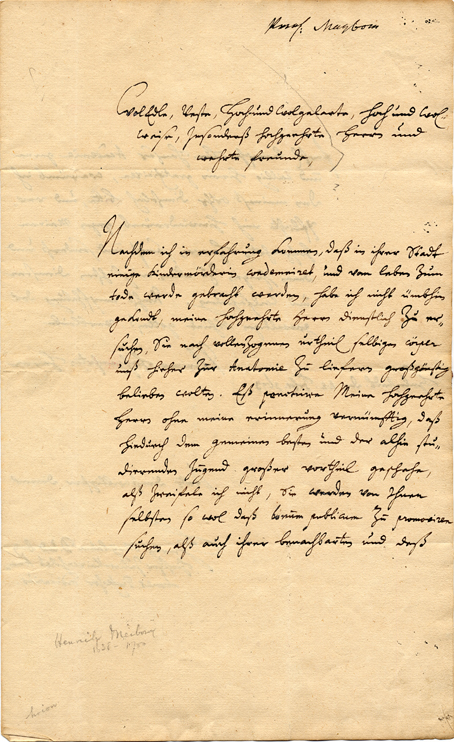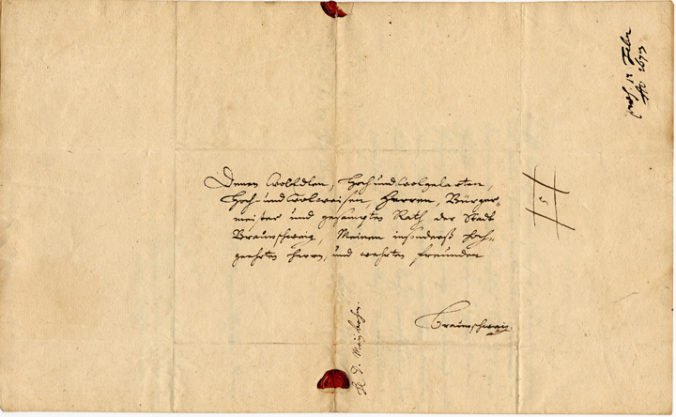Föremål 281 av 400:
Letter from Heinrich Meibom, German Professor of Medicine, History and Poetry in Helmstedt, 11th February 1673
(Detta inlägg finns endast i engelsk version.)
The early universities carried out most of their dissections on animals, particularly pigs and dogs. There were no human dissections in the early period due to restrictions placed by the Roman Catholic Church; cadaveric dissections were introduced in the late 13th century initially for legal purposes – determination of death. These led to the regular use of human cadavers in medical instruction. Later, prisoners who were executed were permitted to be taken for dissection, but no other human corpses were allowed. This was still the case in the 17th century and the constant need for human bodies for dissections at the university is quite drastically illustrated by this letter, addressed to the mayor and the council of the city of Braunschweig. It was important to seize the opportunity when there was going to be an execution in the neighbourhood. In Uppsala in Sweden, for instance, dissections at the anatomical theatre were rare indeed, due to the lack of bodies available.
Signum/Shelfmark: Waller Ms de-03664
The letter in digital form: Letter 1673-02-11, Helmstedt

First page of the letter
Transkription
WolEdle, Veste, Hoch- und Wolgelarte, hoch und wol-
weise, Insonderß hochgeehrte Herrn und
wehrte freunde,
Nachdem ich in erfahrung kommen, daß in ihrer Stadt
einige Kindermörderin condemniret, und vom leben zum
tode werde gebracht werden, habe ich nicht ümbhin
gekondt, meine hochgeehrte Herrn dienstlich zu er-
suchen, Sie nach vollenzogenen urtheil selbigen cörper
unß hieher zur Anatomie zu liefern großgönstig
belieben wolten. Eß penetriren Meine hochgeehrte
Herrn ohne meine erinnerung vernünfftig, daß
hiedurch dem gemeinen besten und der alhie stu-
dierenden Jugend großer vortheil geschehe,
alß zweifele ich nicht, Sie werden von Ihnen
selbsten so wol daß bonum publicum zu promoviren
suchen, alß auch ihrer benachbarten und deß
furstl. braunschw. Lun. Hauses Academie gerne
und willig hierin gratificiren, warümb ich
den meineß orths dienstlich bitte, und ver-
pflichte mich hiewiederümb gegen Meinen
Hochgeehrten Herren sampt und sonderß und
denen Ihrigen zu allen müglichsten diensten
und wilfahrung. Nechst empfhelung der
gewaltigen Obhuet gotteß, verbleibe
Meiner hochgeehrten Herrn
Stets dienstwilligster diener
Hinrich Meybaum D. und bey
hiesiger Julius-Universitet Ana-
tomes Professor ordinarius
Helmstedt. den 11. Febr. 1673
[Address:]
Denen WolEdlen, Hoch und Wolgelarten,
Hoch- und Wolweisen, Herren, Bürger-
meister und gesampten Rath der Stadt
Braunschweig, Meinen insonderß hoch-
geehrten herrn, und wehrten freunden
Braunschweig
Approximate translation
Very Noble, Highly learned and Very Wise, especially Honoured Sirs and dearly-loved Friends,
Having heard that in your town a child-murderess has been condemned to death, I must humbly beg the worthy gentlemen to be good enough to hand over the body to the dissecting room after the sentence has been carried out. I do not need to remind you that this is for the common good and will be a great advantage to the students; also I do not doubt that you yourselves desire to promote the public welfare and that of your neighbours and will willingly gratify the desire of the Academy of the House of Brunswick-Luneburg and I herewith bind myself to render any possible service to you gentlemen, in return.
Commending you to the mighty power of God
Your very humble servant
Hinrich Meybaum, Doctor and
Ordinary Professor of Anatomy at the
Julius University
Heinrich Meibom
Heinrich Meibom the younger (1638-1700) belonged to a German family of several distinguished learned men. His grandfather Heinrich Meibom the elder (1555-1625) was professor of poetry and history at the University of Helmstedt and poëta laureatus in Praha. Marcus Meibom (1630-1711) was employed for some time by Queen Christina at her library in Sweden, and later became librarian in Copenhagen (1653-1663).
Heinrich Meibom (the younger) was in 1664 appointed professor of medicine at the University of Helmstedt and in 1678 he was also appointed professor of history and poetry. In this later position he edited a great number of his grandfather’s historical works. As a professor of medicine he was regarded to be one of the most distinguished physicians of his time. In 1666 he discovered the tarsal glands, the so called glandulae meibomianae, the sebaceous glands embedded in the tarsal plate of each eyelid.
Text & transcription: Håkan Hallberg & Krister Östlund
Image/bild: Uppsala University Library/Uppsala universitetsbibliotek (Alvin)
Detta inlägg har tidigare publicerats på Uppsala universitetsbiblioteks webbplats 2014 / This post has previously been published on the Uppsala University Library’s website 2014.

Last page of the letter

